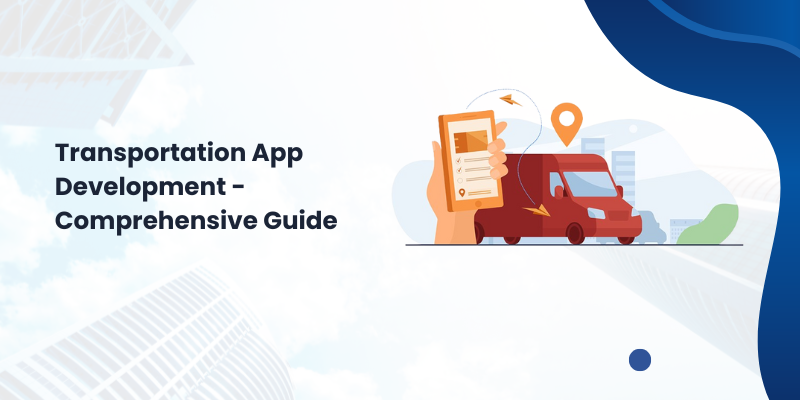The transportation applications have changed our lives for good. Transportation applications serve as a bridge between users and service providers. These apps are actively offering comfort, speed, and flexibility. According to the estimates, the market value of transportation applications is expected to reach $335 billion by 2025. These figures are clear evidence of their remarkable success. In today’s blog, we will talk about one such transportation application.
Transportation apps have set a new standard for the way people move, commute, and connect with mobility services. Users can book rides, track vehicles, and calculate fares anywhere, anytime by simply downloading the app on their phones. It wouldn’t be wrong to say that transportation apps go beyond travel. They enhance urban mobility, create jobs, and reduce traffic. Moreover, they help combat environmental impact through smart, shared solutions like ride-sharing or car-pooling.
Benefits of a Transportation App
There are multiple advantages of Transportation apps. And they also benefit both users and service providers in the following ways.
For Users:
Users can book rides, check routes, and plan trips from anywhere or anytime by installing the transportation app on their phone. They have made commuting easier than ever.
Real-Time Tracking: One of the major benefits they offer is that you can track your ride arrival time. You don’t have to arrive at the railway station or bus stand early out of fear of missing the train or bus, since tracking tools reduce waiting time.
Time-Saving: Users can use these apps to avoid traffic and delays by optimizing their routes.
Cost Transparency: The best thing about these apps is that you can know about the charges before confirming any ride. Not just this, you can compare prices across different modes. This helps users choose a ride based on their preference.
Multiple Transport Options: They also offer multiple transport options for users. For example: bike, scooter, taxis, carpooling, or buses, all on a single platform.
Cashless Transactions: You no longer need to carry cash to book your ride. Since you can easily pay through the app using cards, wallets, or other digital methods.
Saved Location and History: They also allow users to save their frequently visited places. This helps users to find it later with ease in no time. It also makes navigation more personalized.
Safety: Safety becomes the main concern while going alone on a trip or anywhere. However, these apps address those issues effectively. Since you can be sure about ride details like the driver’s name, photo, and car details before pickup, you can also share your live location with your family or friends while travelling. And, most of the Transportation apps include an emergency button that allies for quick access to help if needed.
Benefits for Business and Drivers:
- They reduced operating costs by automating tasks.
- Businesses can save on fuel costs through route optimization.
- Transportation apps also help increase visibility and reach by connecting drivers with more customers than traditional methods.
- Digital payment tools in apps make accounting and revenue tracking easier. It also eliminates the fear of theft or loss.
- Users’ real-time feedback helps a Transportation App company to take measures to improve its Transportation services. It also helps mobile app development companies to keep pace with the evolving market trends.
- With loyalty programs and promotions, businesses can increase customer retention.
- Businesses are also going for an electric transport system to encourage green travel. So, the development of transportation apps benefits not only businesses but also the environment.
Steps to Develop a Transportation APP
If you want to develop a successful transportation app, then you need to know about the following steps:
Step 1: Define your project and goals: The first and foremost step is to determine your project niche. That means deciding what kind of app you want from your chosen Transportation App development company. Such as ride hailing, fleet management, public transport planning, and bike rentals. Because this helps you to recognize your audience base and design. Features tailored to their specific needs.
Step 2: Research to Analyze the Market: Jumping into the development process without thorough research is futile. A detailed study helps you identify user pain points and their expectations. It enables you to design a solution that addresses current issues more effectively than existing competitors. Additionally, you can also be aware of transportation rules and regulations that you need to follow to operate in the region.
Step 3: Design UI/UX: When designing UI/UX, you must know that it directly impacts how users interact with the app. Whatever you touch and see on the app is UI, like buttons, icons, text fields, and other visual elements. Your goal should be to make the app visually appealing, intuitive, and simple to use. On the other hand, UX is how users feel when they use an app. A well-designed UX enhances seamless navigation and an overall enjoyable experience.
Step 4: Developing an MVP: Creating an MVP is a very decisive factor in the development process of a transportation app. An MVP is the most basic version of your project to test your idea in the real world. You can get early feedback and analyse the app’s performance before investing in full-scale development. This approach helps you understand where to focus your resources for future improvements.
Step 5: Testing: Testing is a non-negotiable step to ensure your app is reliable, compatible, and usable across devices and platforms. Testing helps you identify bugs and performance issues for faster and more cost-effective resolution before launch. You can deliver a smoother experience and avoid the possibility of any failures through testing.
Step 6: Deployment: After your app is ready, it will be moved from the development environment to a live production environment where real users can download and use it.
Step 7: Marketing: After deploying the app in the app stores, effective marketing and advertising play an essential role in grabbing the audience’s attention and boost downloads.
Step 8: Post-Launch Support: Your app going live is not enough to achieve long-term success. You need to make sure your app is competitive and bug-free. And this is why post-launch support is important.
Cost of Developing a Transportation App
Several key factors determine the cost of developing a transportation app.
Key Cost Factors:
Platforms like IOS/Android or both
Integrating advanced features will cost more than basic features
No. of third parties
Location of the developers. US-based developers charge more than Asian developers. Developers’ time also adds to the billing hours.
Ongoing updates, server costs, bug fixes
Cost Estimation of a transportation APP:
| Level | Estimated Cost | Development Time |
| MVP (Basic Level) | $25000 to $50000 | 3 to 6 months |
| Standard APP | $70000 to 120000 | 6 to 9 months |
| Advanced Level App | $150000 to 300000 + | 9 to 12 months or more |
Conclusion:
If you want to create a transportation app for ride-hailing, delivery, or logistics, you require solid planning, a realistic budget, and scalable infrastructure, as developing transportation is a resource-intensive project. You can also take help from a successful Transportation App development company. To succeed, you need to focus on building user trust, reliability, and convenience from the very beginning.



